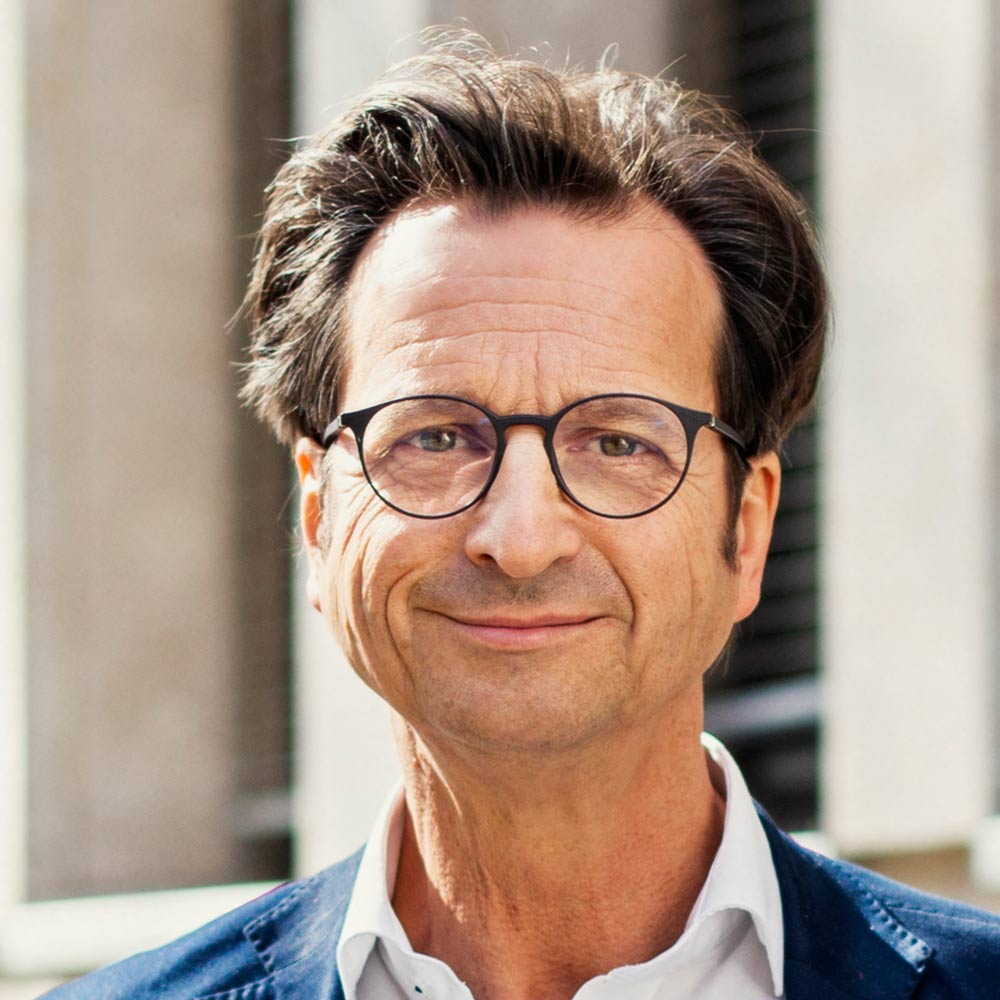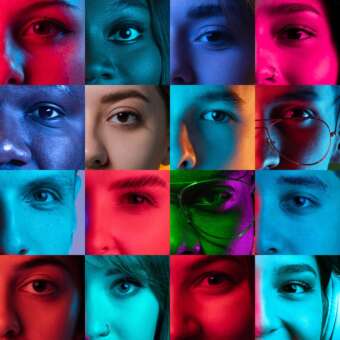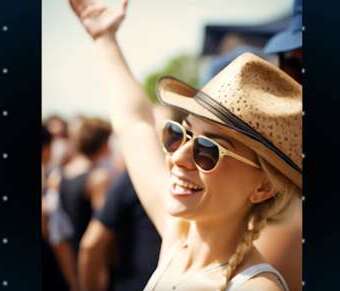Hanau/Cologne May 2024 Do cities have a soul and can urban development be positively influenced with differentiated psychological knowledge? With this assumption in mind, the Kathinka Platzhoff Foundation in Hanau commissioned the rheingold Institute to conduct a study on the inner state of the city of Hanau using depth psychology interviews.
One key finding: Hanau appears to be a patchwork society without a unifying core. In the in-depth interviews with the citizens of Hanau, no overarching city identity is perceptible. Identification is mostly based on the district in which one lives or one's own immediate surroundings. Although some sights are described with an almost touristy view, these postcard impressions do not combine to form a coherent and characteristic overall picture of the city of Hanau. The identity vacuum of the city of Hanau is compensated for by an exuberant, rapturous and fairytale-like idealization. The downsides and dark sides of life in a city are kept out of Hanau and projected onto the neighboring cities of Frankfurt and Offenbach.
This is intended to maintain the idealized image of the city, but at the expense of an active confrontation with the problems and downsides of the city. The exclusion of the perceived ugly, threatening or destructive features of the city creates an exaggeration that is impossible to maintain. Beneath the idealized and beautifully rendered surface, things are rumbling. Hanau appears as a deceptive idyll with an explosive underground.
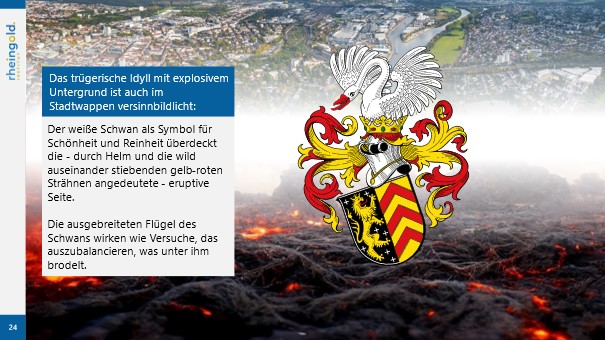
However, the split-off, explosive and destructive flip sides of the reality of life have come crashing down with a vengeance on the city three times in Hanau's recent history, first a massive destruction in one day during the Second World War, then a serious nuclear scandal in the 1980s.
The attack in February 2020 represents the third and currently final trauma for the city of Hanau, which has experienced three times with tremendous force how developments can be reversed. Suddenly, the ideal can turn destructive.
The attack remains an open wound as well as a stigma for the entire city. An adequate process of processing and mourning has been blocked to this day by the immediate lockdown and the process of coming to terms with the events, which was not experienced as sufficiently respectful.
This constantly smouldering and simmering fear of the next catastrophe resulting from the triple traumatization has led to the consolidation of a decommissioning construction. From a psychological point of view, Hanau has fallen into a Sleeping Beauty sleep, which on the one hand is intended to avert the danger of tipping over, but on the other hand is also intended to provide a protective barrier against the accusations of guilt and nuclear or racist stigmatization that are pelting into the city, especially from the outside. Standstill and defense are intended to preserve the fairytale ideal state.
This fearful and defensive shutdown could be replaced by a permeable attitude that overcomes isolation and demands for perfection, thereby promoting cohesion and development. This would require three steps:
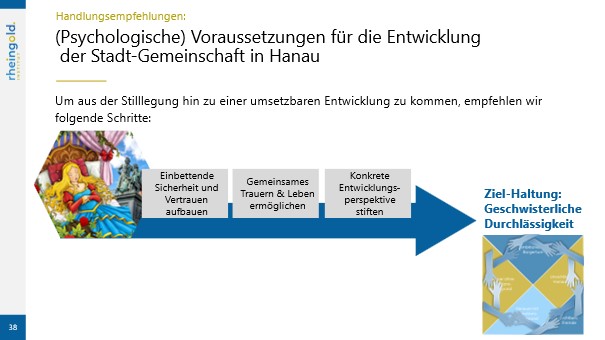
1. build embedding security and trust
Further urban development needs a safe and reliable framework, a stable track bed. A fundamental sense of security must be established for all citizens that makes the city a safe space and strengthens or restores trust in institutions and the police.
2. enabling shared mourning and joie de vivre
The painful pause and shared mourning is the prerequisite for joie de vivre and a vital development of the city. Mourning is a vital process in order to say goodbye to idealizations far removed from life, which were already hindering the city of Hanau before the attack.
The open wound of the attack is currently dynamizing the drifting apart of the city: some feel neither seen nor understood in their suffering and are unable to transform their anger into grief. The others are obdurate in ignoring the attack and cannot resolve their reactance through mourning. This is where the city needs lively meeting spaces in which the different groups in the city can come together.
3. create a concrete development perspective
The citizens want the city to develop in a vital way that allows them to be proud of Hanau. The city of Hanau therefore needs a concrete development perspective that encompasses the entire city. Such a concrete perspective can manifest itself in a successful sports club, a university, a university of applied sciences or cultural lighthouse projects. This can create a common identity.
The development of a vision for the city's future and the projects derived from it should be broadly based - ideally through the establishment of a citizens' council.
The aim is to establish an attitude that is characterized by fraternal permeability.
The Kathinka Platzhoff Foundation is a value-based foundation that has a positive impact on the Hanau social area with various projects and offers equal opportunities for all people and generations.
In order to increase the foundation's impact and find out what moves people in Hanau, the rheingold Institute from Cologne was commissioned at the beginning of 2024 to conduct a study on the situation of life in Hanau using in-depth psychological interviews.
The central question was: What makes Hanau special and how can the unity of the city society be strengthened? Based on the results, the foundation will develop specific new services for the people of Hanau.
At the same time, the Kathinka Platzhoff Foundation would like to use the results to initiate a dialog between the people of Hanau and provide politicians with suggestions for strengthening coexistence in Hanau and implementing social urban development.
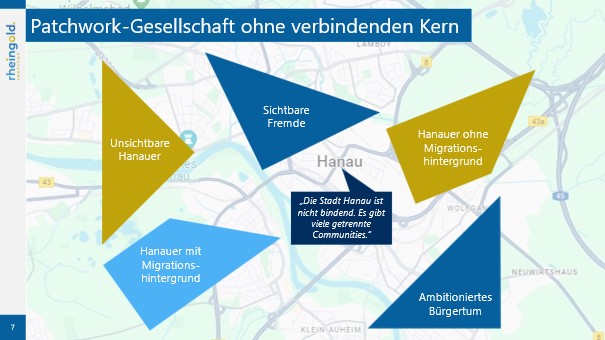
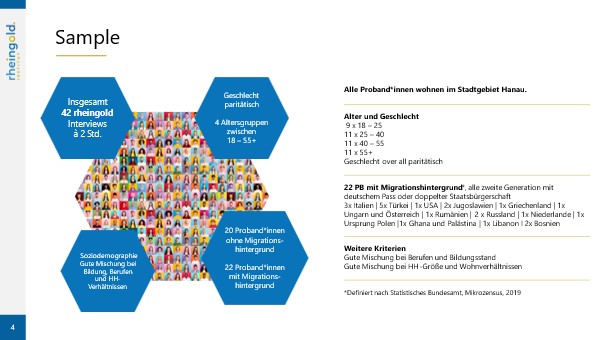
Long version of the results:
Aim and sample of the study: The aim of the study was to gain a fundamental psychological understanding of how people perceive their city of Hanau and how coexistence in the city can be improved. As part of the study, 42 citizens were interviewed in intensive two-hour in-depth psychological interviews. This sample size has proven itself in qualitative psychological studies. It is not representative in a statistical sense - this would require over 1000 test subjects. However, the sample size satisfies the criterion of psychological representativeness: the differentiated composition of the sample and a detailed, multi-stage analysis process ensure that all relevant aspects, dimensions of meaning and impact factors that determine the image of the city of Hanau are represented. During the last 10 interviews conducted, the findings from the previous 32 explorations were confirmed. This justifies the assumption that further explorations would not have yielded any further insights.
The results of the study
Patchwork society without a unifying core
In the in-depth interviews with the citizens of Hanau, no overarching city identity became apparent. Identification is mostly based on the district in which one lives or one's own immediate surroundings. Although some places, sights and museums are described with an almost touristy view, these prestige projects or postcard impressions do not combine to form a coherent and characteristic overall picture of the city of Hanau. For many commuters, Hanau is also a kind of transit city that they use for cheap living, but to which they do not develop a deeper connection.
A look at the different population groups in Hanau also reveals more of a dividing than a unifying factor: "Everyone is among themselves. There are communities within certain groups, but nobody says: "Hey, I'm from Hanau". Hanau appears to be a patchwork society without a unifying core, in which five groups can be differentiated:
Hanau residents without a migration background claim to be open-minded, but are often disappointed and intimidated by the developments of recent years. Many of Hanau's long-established residents are unable to connect with migrant milieus. The "new influx" of migrants causes them great concern and forces them to retreat into their traditional neighborhoods.
Hanau residents with a migration background show solidarity with the original Hanau residents and clearly distinguish themselves from "the new migrants" in their self-description. They feel a sense of belonging to the city of Hanau and appreciate the city center, where they can find appealing stores and cafés and meet their community.
Ambitious bourgeoisie. Here you will find mostly academic, German natives of Hanau who are often committed to their city. They have the necessary resources to get involved, but are often at a loss as to how a better Hanau can be created together. Sometimes, however, they are also afraid of contact with other groups.
Invisible Hanau residents are mostly "better off" and live in the housing projects on the conversion sites. They are described as a gated community that does nothing for the city, but only uses Hanau because of the cheap living space. Many Hanau residents see these new residents as receiving preferential treatment from the city.
Visible strangers are often newcomers with a migration background who are not integrated and with whom the other groups have no personal connection. They therefore appear foreign and are perceived as equally threatening by Hanau residents with and without a migration background and are often used as scapegoats. It is impossible to pinpoint exactly where these people live. Groups of young men in particular are very present in the city center (Freiheitsplatz, bus station).
Compensatory idealization of the city
The identity vacuum of the city of Hanau is compensated for by an exuberant, rapturous and fairytale-like idealization: "Hanau is likeable and diverse. You can see and experience a lot, many nationalities and mentalities can be found here. The employers and shopping opportunities are also great." Hanau is then described as an idyll - as the smallest big city with a wide range of gastronomic options, but without the problems and disadvantages of a real big city: "There isn't a single homeless person in Hanau, we simply don't have any social problems here." Hanau is then praised in the highest terms, but the praise is exhausted in a superficial list of parks and museums, Philippsruhe Castle, the Brothers Grimm monument or the description of beautiful stores: "There are places at the town hall and in front of the Goldsmiths' Museum that are simply fabulously beautiful."
Outsourcing the downsides to other major cities
The downsides and dark sides of living in a city are tried to be kept out of Hanau and are usually projected onto the neighboring cities of Frankfurt and Offenbach: "I wouldn't like to live in Frankfurt when I see the kind of people who hang out at the Hauptwache or the train station." "Sodom and Gomorrah exist in other big cities, but not here."
This is intended to maintain the idealized image of the city, but at the expense of an active confrontation with the problems and downsides of a city. The exclusion of the perceived ugly, threatening or destructive features of the city creates an exaggeration that is impossible to maintain. "Here, on the other hand, there is less crime, it is more middle-class and more suitable for families because it is not so threatening."
Deceptive idyll with an explosive underground
However, the unsettling and explosive downsides of the city, which are supposed to be kept away, are always noticeable in the atmosphere of the interviews. Often they are not openly expressed, but they are articulated in feelings of unease and creepiness, in a tense silence or in sudden and furious discharges of tension. Hanau then appears as a deceptive idyll with an explosive undercurrent. Beneath the idealized and prettified exterior, there are rumblings: "Hanau is like a volcano with flowers on top, you try to keep everything nice, but it's bubbling under the surface."
Traumatic and fateful traffic experiences in the city
However, the split-off, explosive and destructive flip sides of life's realities have come crashing down on Hanau with a vengeance three times in its recent history.
- Towards the end of the Second World War, 90 percent of Hanau was destroyed in a single night
In a 20-minute attack on the night of March 19, the city of the Brothers Grimm was reduced to rubble by an allied air raid. 2,500 people lost their lives and the historic city center was turned into a wasteland of rubble. The city was completely destroyed and the scars of war are still visible in the cityscape today.
- Hanau was considered a nuclear city in the 1980s and is associated with the biggest scandal in the German nuclear industry
In 1988, the nuclear scandal in Hanau came to light. Leading managers of the Hanau-based company Transnuklear were subsequently accused of improperly disposing of nuclear waste on a large scale in Belgium and dumping some of it into the sea.
- In 2020, a racist attack shakes Hanau and the Federal Republic of Germany
On February 19, 2020, a 43-year-old German man shot nine people with a migration background in Hanau. He then shot his mother and himself. The Federal Criminal Police Office classified the murders by the perpetrator, who was characterized by paranoid delusions, as right-wing extremist and racially motivated.
Excursus on the attack: The attack was a traumatizing event for the city of Hanau and all its citizens. The attack was talked about in every interview without support and many people have a personal connection to the attack and can still remember the disturbing events and moments. However, some actively bring up the topic immediately, while others avoid it as much as possible, only mentioning it towards the end or in passing remarks. "The topic of February 19 is like an open wound. I personally find it difficult to come to terms with it. Many others have long since put it to one side."
After the attack, there was an incipient process of coming to terms with the situation and an attempt to strengthen the urban community (Hanau stands together) through the joint mourning process.
However, this was massively disrupted or interrupted by coronavirus and the lockdown in March 2020. "In a situation like this, we all needed comfort and closeness, but we were not allowed to hug or shake hands. And contact with strangers outside the family was frowned upon." The pandemic caused a secondary trauma that blocked the mental processing of the terrible attack: "People were already moving closer together shortly afterwards, but then came corona and now I have the feeling that the rift is even deeper than before because of the attack." The rift was also deepened by the fact that many citizens - across all segments - felt that the investigation work surrounding the closed emergency exit in the shisha bar and the police emergency call that was not answered on the night of the attack was unsatisfactory. As well as the lack of respect shown to the relatives. This led to tertiary trauma for many relatives, which still hinders the grieving process today.
The assassination as an open wound and a stain on the city
Hanau residents - including those who moved to the city after 2020 - are often confronted with the attack in social situations as soon as they identify themselves as "Hanau residents" and have to deal with it. People outside the city associate Hanau almost exclusively with the traumatizing attack. The city usually receives no sympathy, but the finger is pointed at Hanau. Instead of sympathy, many outsiders say: Hanau = racism. "That's always the first thing that comes up, but Hanau is so much more than the attack." The people of Hanau experience this narrow view of their city as less than fair: it seems like a stigma that is attached to the city, which obscures the view of what also distinguishes the city and has made it successful.
Decommissioning: Sleeping beauty sleep and thorn hedge as double protection
The attack in February 2020 represents the third and currently final trauma for the city of Hanau, which has experienced three times with tremendous force how developments can be reversed. Suddenly, the ideal can tip over into the destructive. This constantly smouldering and simmering danger of traffic and tipping over has led to a solidification of a shutdown construction. From a psychological point of view, Hanau has fallen into a Sleeping Beauty sleep, which on the one hand is intended to avert the danger of tipping over, but on the other hand is also intended to provide a protective barrier against the accusations of guilt and nuclear or racist stigmatization that are pelting into the city, especially from the outside.
The dangers and risks associated with any development are to be contained by the Sleeping Beauty sleep. The hedge of thorns is a symbol for the defense against harassing attacks from outside. Standstill and defense are intended to preserve the fairytale-like ideal state.
Defensedefense and development mechanisms of the city of Hanau
Sleeping Beauty symbolizes the psychological construction of a city that moves between an attempted decommissioning on the one hand and an inconsequential revival on the other.
Both sides can be characterized in more detail by three mechanisms.
Idealize: This trait - already described at the beginning - counters the identity vacuum and the problematic stigmatization of the city with a fairytale-like ideal image: "I can't imagine anything that could be better. Actually, everything is already perfect here."
Idealization goes hand in hand with a strategy of avoidance: anything that does not fit into the inviting ideal image is ignored or excluded (similar to the 13th fairy in the Sleeping Beauty fairy tale). In this logic, places or people that could jeopardize the ideal image are avoided.
Keeping quiet: This trait can be seen in many conversations. Although existing problems are seen, attempts are made to make them non-existent by not addressing them: "Many things are covered up, not addressed."
This is linked to the hope of keeping the explosive and difficult aspects associated with the problems out of the city: "In Hanau, we don't talk about problems. We just always pretend that everyone here is friends." Above all, the permanent reminder of the attack is to be prevented by keeping quiet: "Yes, what happened during the attack is bad, but at some point it's enough." Those who break the silence are sometimes afraid of becoming the target of attacks themselves: "Most people are too cowardly to speak openly about everything."
Sorting and separating: Problems that cannot be hushed up are sorted away, separated and projected onto other people or places: "It was even wilder in Offenbach, where those who didn't make it in Frankfurt live. That's why I moved from there to Hanau."
In this logic, problems are often attributed to certain groups of people in a generalized way, e.g. "migrant men" at Freiheitsplatz or the "racist police". "They (men with a migration background) behave like the P.....! You have to treat them exactly like that, otherwise they won't learn. [...] Without them, everything would be much better in Hanau."
This apportioning of blame deepens social divides and makes it more difficult to integrate different groups of people: "There definitely used to be a greater sense of community and a lot of participation. That has changed recently, today people are divided."
Consistent revitalization
Beyond the three decommissioning trains, there is also a great longing for revitalization and an active awakening in the city of Hanau. At the same time, however, this longing also awakens fears that this could activate dormant forces of destruction and that the city could once again - as so often in its recent history - fall into monstrous disarray. This unconsciously attempts to keep the revitalization of the city without consequences - in a kind of "wash me, but don't get me wet" logic.
Avoid and wait and see: Hanau is perceived as stagnating in its development, as many citizens remain in a wait-and-see attitude. Construction sites and projects are often seen as "eternal construction sites": "People wait too long until something is actually implemented."
Developments are often postponed instead of tackling them head-on. Sometimes they also fizzle out in sudden actionism. "There's so much going on in Hanau, but it's often actionism that leads to abandoned projects."
Fairytale-like confidence: The wait-and-see attitude is often supplemented by a principle of hope that everything will work out in the end. Even without any personal involvement or recognizable progress, people believe that problems will solve themselves and that many things will change for the better. Concrete development and solution steps are then replaced by magical thinking or fantasies of redemption with regard to the mayor or municipal initiatives: "They'll sort it out."
Development on a small scale: In the course of the interviews, many small actions come up: pop-up stores, initiatives and art projects - the city of Hanau is bursting with small action groups, but these are often only noticed in their own small circle: "There are so many events throughout the neighborhoods, but you so rarely hear about them." However, the lack of a unifying vision for a common goal for the city sometimes leads to uncoordinated actionism. Many projects deal with similar issues, but due to differing opinions and a lack of dialog, they sometimes act against each other instead of with each other. As a result, despite numerous activities, there is no sustainable development that is visible to everyone: "Hanau is somehow colorful and bustling, but without a concept. In the city, there's the odd fairytale statue here and there or a painted street. But none of it has any substance." Instead, the projects burn out like flashes in the pan instead of developing a unifying and forward-looking force in the long term.
Step 1: Build embedding security and trust
Further urban development needs a safe and reliable framework, a stable track bed. A fundamental sense of security must be established that makes the city a safe space and strengthens or restores trust in institutions and the police.
Public places should be turned into safe meeting places - among other things through lighting concepts, especially in parks. In the city center, further traffic calming can make pedestrians feel safer and increase the quality of their stay. The feeling of safety should be increased, especially at the central bus station on Freiheitsplatz. Currently, women in particular are afraid to ride the bus alone.
Trust in the police should be strengthened, on the one hand through their presence, and on the other through an attitude that makes the police a friend and helper to all Hanau citizens. The police should act in the logic of a village policeman rather than in the SEK logic. They should always be approachable, look kindly on all citizens and meet them in a friendly manner and at eye level without prejudice. In moments of danger, they should act quickly and decisively.
Step 2: Enable shared mourning and joy of life
The painful pause and shared mourning is the prerequisite for shared joie de vivre and a vital development of the city. Mourning is a vital process in order to say goodbye to idealizations far removed from life, which were already hindering the city of Hanau before the attack.
However, mourning is also a healing transitional process that can deal with the traumatic developments surrounding the attack that have not yet healed. Mutual accusations, simmering anger and deep mistrust currently dominate in relation to the attack. This is blocking further development and the city from growing together.
The open wound of the attack is currently dynamizing the city's drifting apart: some feel neither seen nor understood in their suffering and are unable to transform their anger into grief. The others are obdurate in ignoring the attack and cannot resolve their reactance through mourning.
In a symbolic act - analogous to Willi Brandt's genuflection in Warsaw - the traumatic effects of the assassination on relatives and the entire urban society can be commemorated.
Mourning together and saying goodbye to ideals that are hostile to life and demands for perfection can open up the space to celebrate life together again. Festivals - the Bürgerfest, the Brothers Grimm Festival or the carnival parade are very popular, but should be opened up even further and made accessible to all citizens. There is a great desire for festivals to be moved directly into the city center in order to revitalize it: "Hanau must not be a place just for living, but for real experiences. We need more festivals and events, carnival parades must not be canceled!"
Step 3: Create a concrete development perspective
The citizens want the city to develop in a vital way that allows them to be proud of Hanau. The city of Hanau therefore needs a concrete development perspective that encompasses the entire city. Such a concrete perspective creates a common identity, beyond irredeemable idealizations.
In addition to safe spaces and meeting places, the city needs development spaces that promote a common future orientation:
Sport unites: Investing in a sports club with long-term nationwide success to pursue goals, cheer and mourn as a community of destiny.
Education promises development: The establishment of a university or technical college promotes the city's self-esteem and ensures vital rejuvenation.
Creating cultural lighthouse projects that radiate far beyond Hesse, for example with the rededication of the Kaufhof. (Bilbao effect)
The concrete development perspective can credibly take up the existing strengths and potentials of the city:
- Hanau's rich cultural history and tradition
- The diverse art scene, theaters, museums, galleries and the popular weekly market
- Historical sights such as Philippsruhe Palace, Wilhelmsbad and the birthplace of the Brothers Grimm
- The vibrant economy and important location for leading companies from various industries such as Heraeus and Dunlop
- The multicultural city with its diverse population
- Nature and the surrounding area: banks of the Main, many parks and nature reserves
The development of a vision for the city's future and the projects derived from it should be broadly based - ideally through the establishment of a citizens' council.
Target attitude: Fraternal permeability
Thanks to the Brothers Grimm, productive fraternity is one of the city's core attributes. This fraternity could be developed into a modern, fraternal permeability: an attitude that overcomes isolation and demands for perfection and thus promotes cohesion and development.
Fraternal permeability then takes place on two levels:
Fraternal permeability with regard to the foreign
Hanau is becoming a role model for a city culture that promotes encounters between cultures and individual groups. In this logic, for example, the fairy tales of the Brothers Grimm and the fairy tales from 1001 Nights could be combined in a theme park.
Sibling permeability with regard to imperfection
The city awakens from its slumber and overcomes its stagnant ideal image through its courage to experiment and realize and its willingness to take small, partnership-based development steps that can also fail.
The purpose of the Kathinka Platzhoff Foundation, in cooperation with the Walloon-Dutch community, is to provide charitable work in and around Hanau. We implement this in the value-based promotion, accompaniment and support of children, young people, families and senior citizens.


